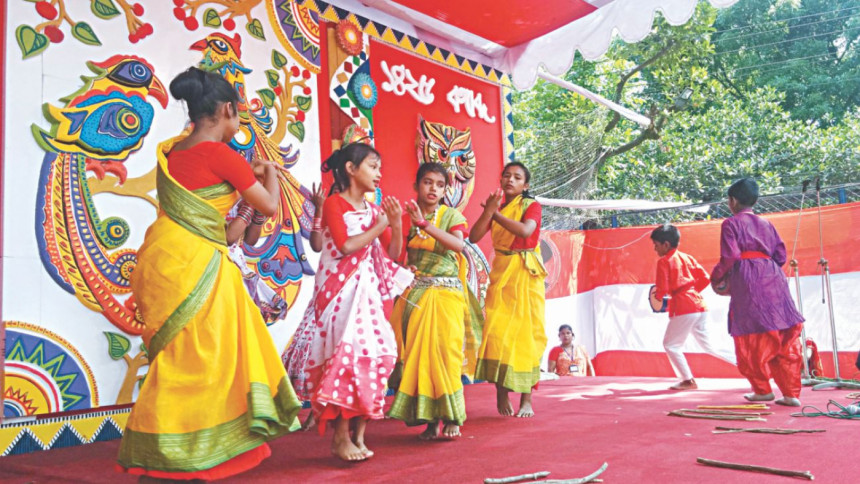Pohela Baisakh in local schools

The Pohela Baisakh (beginning of the Bangla New Year) is being observed in all schools. It takes me back to my own school life in Holy Cross School Dhaka, where we had observed such festivities and it formed the basis of memorizing long poems by Tagore and Nazrul, discovering them through their songs and learning to wear the white saris with red borders. Over the years, the festivities started increasing and the wearing of bangles, application of henna, food fair, other arts and crafts have been added to the Pohela Baisakh observance. This year, I was invited to Chittagong Grammar School Dhaka (CGSD) in Gulshan and I spent a beautiful morning with the children studying there. I was very happy to listen to the group song by the faculty. A favourite number from Shantiniketan, 'Ore greehobashi' being rendered by the school teachers, all attired in pleasant white and red. They featured the Marma dance, Baul and Lalon songs in their show. The top of the cherry was a performance by small kids from the slum studying at the CGSD. They wore the traditional dresses and sand 'Esho he baisakh, esho esho'. It was a joyous moment for me, as I learned that after the regular school, they teach slum children for free and offer them meals to be had in school as well as the ration to take back home. This is the only way to bring social amity that spread the light of education to others who are less fortunate. This curriculum has been prevalent for the last seven years in Dhaka. The CGS was established 25 years back in Chittagong and this is their Dhaka branch. I can only hope that other schools will follow suit and provide education to those needy ones.
From there, I attended an annual celebration of an Academy in Sher E Bangla Nagar, which is a cultural academy by the name of Ava. I was privy to a beautiful morning of songs and dances by tiny tots, all dressed up like dolls and adorning the stage. From group songs, solo songs, dances and recitations, display of their paintings, it was obvious that someone was paying acute attention to the cultural development of the students of the school. Then I had the good fortune of meeting that someone, his name is Mr. Shariar Rabbi, a kind man who is using his own resources and has established this cultural academy to develop our future generation. Indeed, all large trees have started from saplings, and tending to saplings is the most important. In this world of constant competition, how many people are willing to invest their hard earned profits for cultural development? Those who do so deserve to be mentioned. Through this write up, I can only hope that many others will come forward to establish cultural academies in their areas of choice or contribute to those that already exist. These are the steps which will actually bring amity in future. If children enjoy, understand and can participate in their own culture, then they can stay away from all evils. They can have a cultural identity, a sense of belonging and thus can blossom into young, cultured adults. We need more people to invest both in education for the needy and invest in cultural organizations. The culture of Bangladesh is rich like the land, we need someone to tilt.
Nashid Kamal is an Academic, Nazrul exponent and translator


 For all latest news, follow The Daily Star's Google News channel.
For all latest news, follow The Daily Star's Google News channel. 



Comments